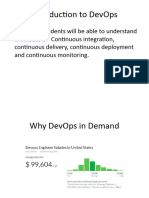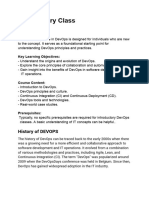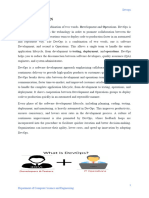DevOps Notes for B.
Tech
1. Introduction to DevOps
Definition: DevOps = Development + Operations → A culture, practice, and set of tools that
integrates software development and IT operations.
Goal: Shorten SDLC, deliver CI/CD, improve quality, and collaboration.
Why DevOps?
- Faster deployment
- Improved collaboration
- Reduced failure rates
- Automation of repetitive tasks
2. DevOps Life Cycle
Stages: Plan → Code → Build → Test → Release → Deploy → Monitor
Tools: Jira, Git, Maven, Jenkins, Docker, Kubernetes, Prometheus, Grafana.
3. Key DevOps Practices
- Continuous Integration (CI)
- Continuous Deployment (CD)
- Infrastructure as Code (IaC)
- Microservices
- Monitoring & Logging
- Collaboration & Communication
4. Important DevOps Tools
Version Control: Git, GitHub, GitLab
CI/CD: Jenkins, GitHub Actions, GitLab CI/CD
Containerization: Docker, Kubernetes
Configuration Management: Ansible, Puppet, Chef
Monitoring: Prometheus, Grafana, ELK Stack
5. DevOps Workflow Example
1. Developer pushes code → GitHub
2. CI Pipeline → Jenkins
3. Build artifact → Docker image
4. Deployment → Kubernetes
5. Monitoring → Prometheus + Grafana
6. Advantages of DevOps
- Faster delivery
- Improved quality
- Automated workflows
- Better collaboration
- Reduced downtime
7. Challenges in DevOps
- Cultural resistance
- Toolchain complexity
- Security concerns
- Legacy integration
8. DevOps in Real World
- Netflix: Chaos engineering, CI/CD
- Amazon: Automated scaling
- Google: SRE model
9. DevOps and Cloud Computing
AWS: CodePipeline, CodeBuild, CodeDeploy
Azure DevOps: Repos, Pipelines, Boards
Google Cloud: Cloud Build, Cloud Run
10. Future of DevOps
- AIOps
- GitOps
- Serverless DevOps
- DevSecOps

























































